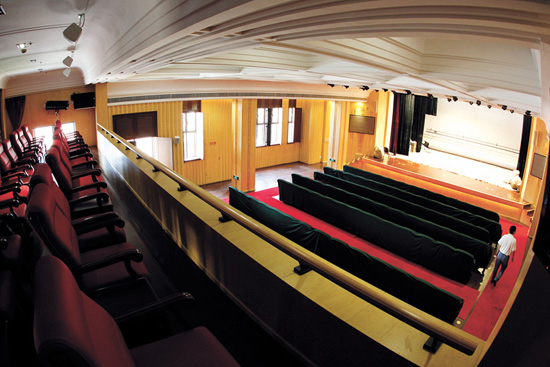 |
|
The 180-seat theater at the Shanghai Kunqu Opera Troupe is believed to be ideal for audience to enjoy the delicate performing art of Kunqu, appreciating the characters’ emotions and subtle shifts such as the flick of a finger and lifting of a hem. — Gao Jianping
|
In a small theater, people can better appreciate characters’ emotions and subtle shifts through their singing, dialogue and minute gestures, such as the flick of a finger and lifting of a hem. They can better understand the different meanings of “orchid-like” finger gestures and water-sleeve movements in Kunqu Opera.
Other traditional operas can also be staged in small settings, which critic Chen considers a “good supplement to big stage performances.”
The new small theater on Shaoxing Road will open in October with a series of performances, many of them well-known excerpts of the classics. The flavor of the originals will be retained while performance style will be more flexible.
Before the curtain rises, critics and experts will give brief introductions to the operas and comment during intermissions.
The troupe is considering staging light-hearted and romantic performances on traditional festivals such as Chinese Valentine’s Day and the Lantern Festival.
Promoting traditional art
In addition to the theater, the renovated villa contains a show room for regular exhibitions of costumes, props and video clips that give visitors insight into the opera’s art and history.
The multi-function hall is a venue for conferences, various cultural events and salons for members, as well as buffets.
The 1930s villa is the former French Police Club, where dance parties were held for the policemen and their family members. After 1949, it became a venue for the Shanghai Peking Opera Troupe. In 1979 the Shanghai Kunqu Opera Troupe moved in. The villa has witnessed performances by many famous Kunqu and Peking opera artists. It was also rehearsal spaces.
Cultural landmark
The 38-million-yuan (US$6.13 million) renovation preserves the three-storey villa’s original exterior, while the interior is elegant. A staircase twisting between floors, chandeliers and stained glass windows create a nostalgic atmosphere.
The aim is to make the villa a cultural landmark on Shaoxing Road. The road is already famous for its plane trees, tranquility and cultural atmosphere. Visitors can find book stores, stylish cafes and publishing houses.
It is also expected to be developed into a new tourist attraction along with nearby Shanghai Culture Square, Tianzifang art hub and the Liuli China Museum of art glass.
Since the 1990s, the troupe has promoted Kunqu Opera to young audiences around China. It has around 8,000 club members from all over China, mostly professionals and people interested in Chinese culture.
Kunqu Opera lectures and salons will be held regularly in the renovated villa. Opera fans can attend “Follow Me” classes to learn basic singing and performance skills from members of the troupe. Special performances will cater to the tastes of expatriates.
Kunqu Opera arose around 600 years ago around Kunshan City near Suzhou in Jiangsu Province. In 2001 UNESCO listed it as a “masterpiece of oral and intangible heritage of humanity.”
In recent years Kunqu Opera artists and enthusiasts have tried to innovate, adapt and make the opera more appealing and accessible to young people. This typically means condensing operas which could be performed for many hours.
Taiwan writer and scholar Pai Hsien-yung has created successful adaptations of the classics “The Peony Pavilion” and “The Story of the Jade Hairpin.” They feature simple plot lines and spectacular stage settings.
Zhang Jun, known as the “Kunqu Opera Prince,” has controversially fused New Age, jazz, electronic and rock’n’roll with traditional Kunqu Opera scores and presented “Peony Pavilion” in Kezhi Garden in suburban Zhujiajiao water town.
We recommend:
